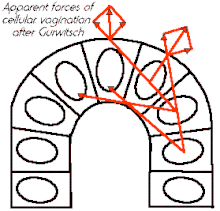From Wikipedia, the free encyclopedia
- This article is about the concept in developmental biology. For Rupert Sheldrake's concept of the same name, see the corresponding section of Morphic field.
Contents[hide] |
[edit] Historical development
The concept of the morphogenetic field, fundamental in the early twentieth century to the study of embryological development, was first introduced in 1910 by Alexander G. Gurwitsch.[6] Experimental support was provided by Ross Granville Harrison's experiments transplanting fragments of a newt embryo into different locations.[7]Harrison was able to identify "fields" of cells producing organs such as limbs, tail and gills and to show that these fields could be fragmented or have undifferentiated cells added and a complete normal final structure would still result. It was thus considered that it was the "field" of cells, rather than individual cells, that were patterned for subsequent development of particular organs. The field concept was developed further by Harrison's friend Hans Spemann, and then by Paul Weiss and others.[3]
By the 1930s, however, the work of geneticists, especially Thomas Hunt Morgan, revealed the importance of chromosomes and genes for controlling development, and the rise of the new synthesis in evolutionary biology lessened the perceived importance of the field hypothesis. Morgan was a particularly harsh critic of fields since the gene and the field were perceived as competitors for recognition as the basic unit of ontogeny.[3] With the discovery and mapping of master control genes, such as the homeobox genes the pre-eminence of genes seemed assured. But in the late twentieth century the field concept was "rediscovered" as a useful part of developmental biology. It was found, for example, that different mutations could cause the same malformations, suggesting that the mutations were affecting a complex of structures as a unit, a unit that might correspond to the field of early 20th century embryology.
Scott Gilbert proposes that the morphogenetic field is a middle ground between genes and evolution.[3] That is, genes act upon fields, which then act upon the developing organism.[3] Jessica Bolker describes morphogenetic fields not merely as incipient structures or organs, but as dynamic entities with their own localized development processes, which are central to the emerging field of evolutionary development ("evo-devo").[8]
[edit] See also
[edit] References
- ^ Alberts B, Johnson A, Lewis J, Raff M, Roberts K, Walter P (2002). Universal Mechanisms of Animal Development. in: Molecular Biology of the Cell (4th ed.). Garland. ISBN 0-8153-3218-1. http://www.ncbi.nlm.nih.gov/books/bv.fcgi?&rid=mboc4.section.3792.
- ^ Jacobson AG, Sater AK (1 November 1988). "Features of embryonic induction". Development 104 (3): 341–59. PMID 3076860. http://dev.biologists.org/cgi/reprint/104/3/341.
- ^ a b c d e Gilbert SF, Opitz JM, Raff RA (1996). "Resynthesizing evolutionary and developmental biology". Dev. Biol. 173 (2): 357–72. doi:10.1006/dbio.1996.0032. PMID 8605997.
- ^ a b Gilbert SF (2003). Developmental biology (7th ed.). Sunderland, Mass: Sinauer Associates. pp. 65–6. ISBN 0-87893-258-5.
- ^ Alberts B, et al. (2002). Organogenesis and the Patterning of Appendages. in: Molecular Biology of the Cell (4th ed.). Garland. ISBN 0-8153-3218-1. http://www.ncbi.nlm.nih.gov/books/bv.fcgi?rid=mboc4.figgrp.3898.
- ^ Beloussov, LV (1997). "Life of Alexander G. Gurwitsch and his relevant contribution to the theory of morphogenetic fields". International Journal of Developmental Biology 41 (6): 771–779. http://www.ijdb.ehu.es/web/contents.php?vol=41&issue=6&doi=9449452., with comment by SF Gilbert and JM Optiz.
- ^ de Robertis, EM; Morita, EA; Cho, KWY (1991). "Gradient fields and homeobox genes". Development 112 (3): 669–678. PMID 1682124. http://dev.biologists.org/cgi/reprint/112/3/669.pdf.
- ^ Bolker, JA (2000). "Modularity in Development and Why It Matters to Evo-Devo". American Zoologist 40 (5): 770–776. doi:10.1668/0003-1569(2000)040[0770:MIDAWI]2.0.CO;2. http://icb.oxfordjournals.org/cgi/content/full/40/5/770.
[edit] Further reading
- Davidson EH (1 July 1993). "Later embryogenesis: regulatory circuitry in morphogenetic fields". Development 118 (3): 665–90. PMID 7915668. http://dev.biologists.org/cgi/reprint/118/3/665.
- Gilbert SF (2006). "The "Re-discovery" of Morphogenic Fields. in: DevBio: a companion to Developmental Biology, 8th ed.". Sinauer Associates. http://8e.devbio.com/article.php?ch=3&id=18. Retrieved 2007-07-20.
[edit] External links
See a morphogenetic field model and simulation at: Lahoz-Beltra, R., Selem Mojica, N., Perales-Gravan, C., Navarro, J., Marijuan, P.C., 2008. Towards a Morphogenetic Field Theory. http://bioinformatica.net/mf-project/index.html
| ||||||||||||||||||||||||||


No comments:
Post a Comment